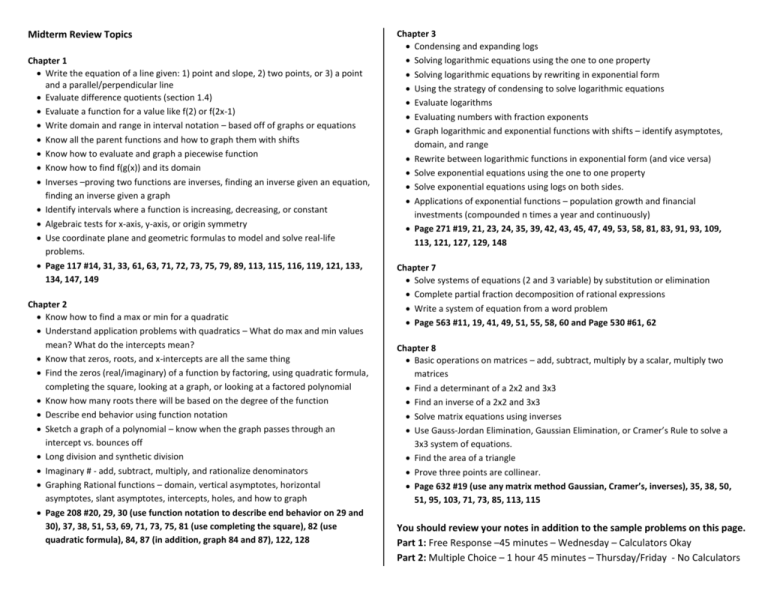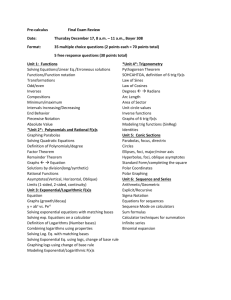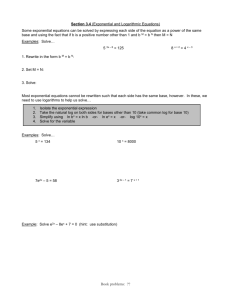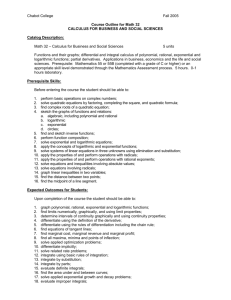Midterm Review Topics
advertisement

Midterm Review Topics Chapter 1 Write the equation of a line given: 1) point and slope, 2) two points, or 3) a point and a parallel/perpendicular line Evaluate difference quotients (section 1.4) Evaluate a function for a value like f(2) or f(2x-1) Write domain and range in interval notation – based off of graphs or equations Know all the parent functions and how to graph them with shifts Know how to evaluate and graph a piecewise function Know how to find f(g(x)) and its domain Inverses –proving two functions are inverses, finding an inverse given an equation, finding an inverse given a graph Identify intervals where a function is increasing, decreasing, or constant Algebraic tests for x-axis, y-axis, or origin symmetry Use coordinate plane and geometric formulas to model and solve real-life problems. Page 117 #14, 31, 33, 61, 63, 71, 72, 73, 75, 79, 89, 113, 115, 116, 119, 121, 133, 134, 147, 149 Chapter 2 Know how to find a max or min for a quadratic Understand application problems with quadratics – What do max and min values mean? What do the intercepts mean? Know that zeros, roots, and x-intercepts are all the same thing Find the zeros (real/imaginary) of a function by factoring, using quadratic formula, completing the square, looking at a graph, or looking at a factored polynomial Know how many roots there will be based on the degree of the function Describe end behavior using function notation Sketch a graph of a polynomial – know when the graph passes through an intercept vs. bounces off Long division and synthetic division Imaginary # - add, subtract, multiply, and rationalize denominators Graphing Rational functions – domain, vertical asymptotes, horizontal asymptotes, slant asymptotes, intercepts, holes, and how to graph Page 208 #20, 29, 30 (use function notation to describe end behavior on 29 and 30), 37, 38, 51, 53, 69, 71, 73, 75, 81 (use completing the square), 82 (use quadratic formula), 84, 87 (in addition, graph 84 and 87), 122, 128 Chapter 3 Condensing and expanding logs Solving logarithmic equations using the one to one property Solving logarithmic equations by rewriting in exponential form Using the strategy of condensing to solve logarithmic equations Evaluate logarithms Evaluating numbers with fraction exponents Graph logarithmic and exponential functions with shifts – identify asymptotes, domain, and range Rewrite between logarithmic functions in exponential form (and vice versa) Solve exponential equations using the one to one property Solve exponential equations using logs on both sides. Applications of exponential functions – population growth and financial investments (compounded n times a year and continuously) Page 271 #19, 21, 23, 24, 35, 39, 42, 43, 45, 47, 49, 53, 58, 81, 83, 91, 93, 109, 113, 121, 127, 129, 148 Chapter 7 Solve systems of equations (2 and 3 variable) by substitution or elimination Complete partial fraction decomposition of rational expressions Write a system of equation from a word problem Page 563 #11, 19, 41, 49, 51, 55, 58, 60 and Page 530 #61, 62 Chapter 8 Basic operations on matrices – add, subtract, multiply by a scalar, multiply two matrices Find a determinant of a 2x2 and 3x3 Find an inverse of a 2x2 and 3x3 Solve matrix equations using inverses Use Gauss-Jordan Elimination, Gaussian Elimination, or Cramer’s Rule to solve a 3x3 system of equations. Find the area of a triangle Prove three points are collinear. Page 632 #19 (use any matrix method Gaussian, Cramer’s, inverses), 35, 38, 50, 51, 95, 103, 71, 73, 85, 113, 115 You should review your notes in addition to the sample problems on this page. Part 1: Free Response –45 minutes – Wednesday – Calculators Okay Part 2: Multiple Choice – 1 hour 45 minutes – Thursday/Friday - No Calculators










